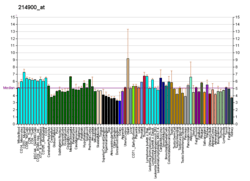ZKSCAN1
Zinc finger protein with KRAB and SCAN domains 1 is a protein that in humans is encoded by the ZKSCAN1 gene.[5]
See also
References
Further reading
- Huebner K, Druck T, Croce CM, Thiesen HJ (1991). "Twenty-seven nonoverlapping zinc finger cDNAs from human T cells map to nine different chromosomes with apparent clustering". Am. J. Hum. Genet. 48 (4): 726–40. PMC 1682948. PMID 2014798.
- Thiesen HJ (1991). "Multiple genes encoding zinc finger domains are expressed in human T cells". New Biol. 2 (4): 363–74. PMID 2288909.
- Rousseau-Merck MF, Duro D, Berger R, Thiesen HJ (1995). "Chromosomal localization of two KOX zinc finger genes on chromosome bands 7q21-q22". Ann. Genet. 38 (2): 81–4. PMID 7486829.
- Tommerup N, Vissing H (1995). "Isolation and fine mapping of 16 novel human zinc finger-encoding cDNAs identify putative candidate genes for developmental and malignant disorders". Genomics. 27 (2): 259–64. doi:10.1006/geno.1995.1040. PMID 7557990.
- Strausberg RL; Feingold EA; Grouse LH; et al. (2003). "Generation and initial analysis of more than 15,000 full-length human and mouse cDNA sequences". Proc. Natl. Acad. Sci. U.S.A. 99 (26): 16899–903. doi:10.1073/pnas.242603899. PMC 139241. PMID 12477932.
- Scherer SW; Cheung J; MacDonald JR; et al. (2003). "Human Chromosome 7: DNA Sequence and Biology". Science. 300 (5620): 767–72. doi:10.1126/science.1083423. PMC 2882961. PMID 12690205.
- Jikuya H; Takano J; Kikuno R; et al. (2003). "Characterization of long cDNA clones from human adult spleen. II. The complete sequences of 81 cDNA clones". DNA Res. 10 (1): 49–57. doi:10.1093/dnares/10.1.49. PMID 12693554.
- Ota T; Suzuki Y; Nishikawa T; et al. (2004). "Complete sequencing and characterization of 21,243 full-length human cDNAs". Nat. Genet. 36 (1): 40–5. doi:10.1038/ng1285. PMID 14702039.
- Gerhard DS; Wagner L; Feingold EA; et al. (2004). "The Status, Quality, and Expansion of the NIH Full-Length cDNA Project: The Mammalian Gene Collection (MGC)". Genome Res. 14 (10B): 2121–7. doi:10.1101/gr.2596504. PMC 528928. PMID 15489334.
- Olsen JV; Blagoev B; Gnad F; et al. (2006). "Global, in vivo, and site-specific phosphorylation dynamics in signaling networks". Cell. 127 (3): 635–48. doi:10.1016/j.cell.2006.09.026. PMID 17081983.
This article is issued from
Wikipedia.
The text is licensed under Creative Commons - Attribution - Sharealike.
Additional terms may apply for the media files.





